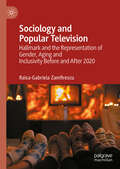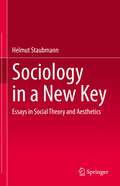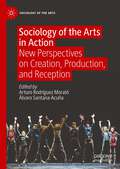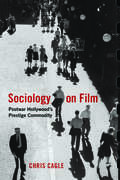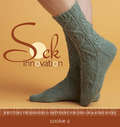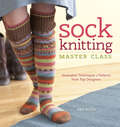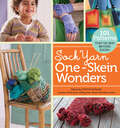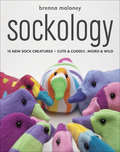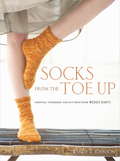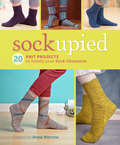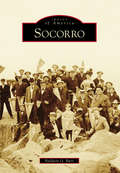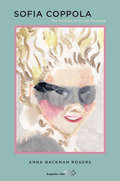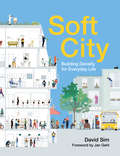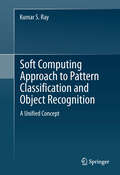- Table View
- List View
Sociology and Architectural Design (Social Science Frontiers)
by John ZeiselThis book, encouraging more effective collaboration between professional architects and social scientists, outlines how social science research can aid the design process, detailing how physical environment relates to behavior. With a foreword by Hugh F. Cline.
Sociology and Popular Television: Hallmark and the Representation of Gender, Aging and Inclusivity Before and After 2020
by Raisa-Gabriela ZamfirescuThis book examines representations of gender, age and identity across the Hallmark film and television output in relation to specific periods of time that pertain to changes within the specific entertainment sector. Using a comprehensive collection of 628 original Hallmark television films released between January 2015 and December 2023, the book applies content analysis to a variety of quantitative, qualitative, and mixed data, including behind-the-scenes credits, actors and actresses, characters and their narratives, promotional posters, Facebook comments, and official synopsis. In addition to examining diversity of race and religion, it analyses ageism through the portrayal of elders and young people in idealized imagery and stereotypes, inclusivity of LGBTQ and disabled characters, and ageism in relation to both masculinities and femininities. This book will be of interest to readers in fields including gender studies and sociology, visual communication, film and television studies, aging, media and communications, and popular culture.
Sociology in a New Key: Essays in Social Theory and Aesthetics
by Helmut StaubmannThis book presents essays that address fundamental issues in social and cultural theory by viewing them through the lens of aesthetic theory. Drawing on the aesthetic theories of Theodor W. Adorno, Gregory Bateson, Jean-Marie Guyau, Talcott Parsons and Georg Simmel, it suggests a new take on basic sociological concepts and methodologies. The chapters cover a wide range of topics, including the sensuality of social action, social construction of unreality, and The Rolling Stones’ enduring success as a reflection of our society and culture. The book’s title Sociology in a New Key refers to a classic work by Susanne K. Langer, whose Philosophy in a New Key argued for a reorientation of modern philosophical thought based on a thorough account of symbolism in general and of the arts in particular. In this way, the basic ideas and assumptions of the philosophical tradition are transposed to new understandings and perspectives. After all, it was Georg Simmel himself who claimed to have gained several of his general theoretical insights “via the detour of reflections on the essence of art.” The book will appeal to scholars and students of the sociology of the arts and music, and to anyone interested in the intersection of social theory and aesthetics.
Sociology of Art: A Reader
by Jeremy TannerIntroducing the fundamental theories and debates in the sociology of art, this broad ranging book, the only edited reader of the sociology of art available, uses extracts from the core foundational and most influential contemporary writers in the field. As such it is essential reading both for students of the sociology of art, and of art history. Divided into five sections, it explores the following key themes: * classical sociological theory and the sociology of art * the social production of art * the sociology of the artist * museums and the social construction of high culture* sociology aesthetic form and the specificity of art. With the addition of an introductory essay that contextualizes the readings within the traditions of sociology and art history, and draws fascinating parallels between the origins and development of these two disciplines, this book opens up a productive interdisciplinary dialogue between sociology and art history as well as providing a fascinating introduction to the subject.
Sociology of the Arts in Action: New Perspectives on Creation, Production, and Reception (Sociology of the Arts)
by Arturo Rodríguez Morató Alvaro Santana-AcuñaThis edited collection carries out an extensive coverage of the sociology of arts’ most characteristic thematic areas (production, creation, the artwork, and reception) across an important range of artistic fields, from the most traditional to the more unusual. It makes an argument for the theoretical creativity and empirical expansion that characterizes the study of contemporary sociology of the arts. Such creativity is present in the increasingly predominant approach to a sociology of the arts in action, in all areas of inquiry within the discipline. The range of theoretical paradigms evoked is rich, analysing several of the most important theoretical frameworks currently handled in the discipline (Bourdieu, Becker, Peterson, ANT), and combining them with the works of many other influential contemporary specialists (De Nora, Hennion, Lamont, Menger and Born et al.). The book also establishes links to less known theoretical frameworks and some from different fields including economic sociology,microsociology, ethnomethodology, semiotics, and cultural history. The volume argues that Spanish-speaking scholars are now at the forefront of new developments in the field of the sociology of the arts, and is the first effort to gather research by these influential Spanish-language scholars in a single volume for an English-language audience.
Sociology on Film: Postwar Hollywood's Prestige Commodity
by Professor Chris CagleAfter World War II, Hollywood’s “social problem films”—tackling topical issues that included racism, crime, mental illness, and drug abuse—were hits with critics and general moviegoers alike. In an era of film famed for its reliance on pop psychology, these movies were a form of popular sociology, bringing the academic discipline’s concerns to a much broader audience. Sociology on Film examines how the postwar “problem film” translated contemporary policy debates and intellectual discussions into cinematic form in order to become one of the preeminent genres of prestige drama. Chris Cagle chronicles how these movies were often politically fractious, the work of progressive directors and screenwriters who drew scrutiny from the House Un-American Activities Committee. Yet he also proposes that the genre helped to construct an abstract discourse of “society” that served to unify a middlebrow American audience. As he considers the many forms of print media that served to inspire social problem films, including journalism, realist novels, and sociological texts, Cagle also explores their distinctive cinematic aesthetics. Through a close analysis of films like Gentleman’s Agreement, The Lost Weekend, and Intruder in the Dust, he presents a compelling case that the visual style of these films was intimately connected to their more expressly political and sociological aspirations. Sociology on Film demonstrates how the social problem picture both shaped and reflected the middle-class viewer’s national self-image, making a lasting impact on Hollywood’s aesthetic direction.
Sock Innovation: Knitting Techniques and Patterns for One-of-a-kind Socks
by Cookie ApichairukUnconventional, rule-breaking socks are part and parcel in this unique guide to sock knitting that includes 15 new sock patterns. The skills of the average sock knitter are increased through design exploration and advanced stitch manipulation, treating the sock as a knitted canvas where elements are strategically and intentionally placed. New designs of floral lace patterns, angular geometric shapes, and unusual cables are presented along with detailed instructions on modifications to suit needs and aesthetics. The incredible range of style and complexity in this guide runs from sweet and simple to delightfully imaginative.
Sock It to Me: Creepy, Crazy & Strangely Appealing
by Brenna MaloneyAn easy method to faster quilt-making, and incredible patterns to make use of your scrap stash. What if you could piece quilts even faster, work on more than one quilt simultaneously and save money, fabric and thread all at the same time? Bonnie K. Hunter will show you how to put the concept of Leaders & Enders to work quickly and easily, expanding your creativity, and upping your productivity all at the same time. If you have ever found yourself paralyzed by your stash, overwhelmed by scraps you just can't bear to toss out, arm yourself with a new rotary blade for your cutter, make yourself a cup of tea and start reading. This book is not only full of beautiful scrap quilts that can be made in between the lines of other sewing, but also contains many ideas for getting your ever burgeoning scrap stash under control, into useable sized pieces that work well with one another, and ready to be sewn into quilts you've always wanted to make. Bonnie K. Hunter has done it again!
Sock Knitting Master Class: Innovative Techniques + Patterns from Top Designers
by Ann BuddWork from the ground up with knitwear design: create your own socks!Sock Knitting Master Class showcases methods for designing and knitting creative socks, featuring signature elements and techniques from 16 top designers. You'll learn what makes good sock design, and then dive into knitting 18 spectacular, brand-new patterns featuring the widest variety of techniques.With patterns divided into two sections by top-down and toe-up construction, Sock Knitting Master Class explores such techniques as cables, twisted stitches, lace, stranded colorwork, entrelac, shadow knitting, and intarsia worked in the round. Plus, you'll discover inventive ways to start and end socks, shape heels and toes, and knit the soles. Sock Knitting Master Class is an all-star assembly of the most inventive, exciting designers working in socks including Cookie A, Kathryn Alexander, Nancy Bush, Cat Bordhi, Priscilla Gibson-Roberts, Anne Hanson, Melissa Morgan-Oakes, Meg Swanson, Anna Zilboorg, and many more. And you'll also learn how each yarn contributes to the overall design from Clara Parkes.
Sock Yarn One-Skein Wonders®: 101 Patterns That Go Way Beyond Socks! (One-Skein Wonders)
by Judith DurantSock yarn isn’t just for socks anymore! Veteran knitter Judith Durant presents 101 original projects that can be created from just a single skein of sock yarn, including adorable baby clothes, warm hats, beautiful scarves, and even a dog sweater. A quick and creative way to use up leftovers, many of these projects knit up in less than three hours. Adapted from designs contributed by yarn shops and crafters from throughout North America, knitters of all types will delight in these fun and stylish creations.
Sockology: 16 New Sock Creatures, Cute & Cuddly ... Weird & Wild
by Brenna Maloney“[A] gallery of fabulously funky projects . . . Instructions are provided for some lovely little animals” from the author of the bestselling Socks Appeal (Australian Homespun).Breanna Maloney is back with a new posse of cute creatures! In this sequel book Sockology, you are encouraged to take it one step further with slightly more complex construction and endless inspiration. From a lovable jointed bear and fluffy sheep to a quirky many-eyed alien, these 16 projects will surely keep you entertained (and challenged) for hours. Don’t worry, detailed hand-drawn templates are included to guide you every step of the way.Praise for Socks Appeal“Assigned to cover the recession and housing crises that was brewing in 2008, Maloney started making sock animals for her children as a stress reducer. Maloney found that the more traumatic her job got, the more creating a new sock animal each night seemed to help. Maloney’s wit and candor in how she writes the instructions is hilarious.” —Publishers Weekly“Her collection takes the classic idea of the sock monkey and makes it into something new using basic techniques and imagination . . . Most of the projects are easy enough for (supervised) children, but adults who like a little whimsy won’t be disappointed, either.” —Library Journal
Socks Appeal: 16 Fun & Funky Friends Sewn from Socks
by Brenna Maloney“Turn your favorite socks into adorable bunnies, kittens, hamsters, turtles, lions and more! Included are step-by-step photos for picture perfect results.” —Crafts n’ ThingsStitch up a sweet and silly sock critter tonight! Sixteen projects are categorized by skill level, from super-simple to more advanced. Your dryer ate a brand-new sock? No worries—stray singles can now become the perfect gift in just an hour. Enjoy making whimsical stuffed animals using baby socks, knee socks, crew socks . . . any kinds of socks rock! Give your critter’s face plenty of creative expression by embellishing with your favorite buttons and embroidery. Several projects are easy enough for children to make for their own toybox, but you’ll want a bunch of these irresistible cuties for yourself, too!“Assigned to cover the recession and housing crises that was brewing in 2008, Maloney started making sock animals for her children as a stress reducer. Maloney found that the more traumatic her job got, the more creating a new sock animal each night seemed to help. Maloney’s wit and candor in how she writes the instructions is hilarious.” —Publishers Weekly“Her collection takes the classic idea of the sock monkey and makes it into something new using basic techniques and imagination . . . Most of the projects are easy enough for (supervised) children, but adults who like a little whimsy won’t be disappointed, either.” —Library Journal
Socks from the Toe Up: Essential Techniques and Patterns from Wendy Knits
by Wendy D. JohnsonDiscover a new approach to sock knitting with Wendy D. Johnson and Socks from the Toe Up. This approach, made famous by her popular blog WendyKnits.net, will turn even the most reluctant knitter into a toe-up nut. Knitting a sock from the toe up saves yarn and always gives a perfect fit. And? No grafting! Wendy provides all the how-tos, tips, and techniques you need, as well as the pros and cons behind all of the cast-on, toe, heel, and bind-off options, gleaned from her years of experience. With more than 20 fun and beautiful patterns, Socks from the Toe Up has a sock for every foot. Whether you like bold textures or hearts and flowers, delicate lace or Bavarian cables, you (and your feet) will be covered here. Even if you're casting on your first sock, or have been a top-down sock knitter for ages, you'll find patterns and projects here that'll keep your needles humming. Socks from the Toe Up is the hands-down best guide for toe-up socks.
Socks à la Carte 2 Toes up!
by Jonelle Raffino Katherine CadeThese socks will keep you on your toes! Jonelle Raffino and Katherine Cade are back with more toe-tapping designs in this follow-up to the best sellingSocks ? la Carte. Create perfectly fitting pairs every time with toe-up construction and sizing tips from the experts. Become a master sock designer by combining interchangeable foot, leg and cuff patterns to create your own original designs. Perfect for sock mavens and beginners alike,Socks ? la Carte 2combines design savvy with easy-to-follow instructions to knit eye-catching socks every time. Inside you'll find: Innovative flip pages: Preview your designs before you knit them by matching the foot, leg and cuff of your choice. See what your socks will look like before you knit them. Easy tutorials: Clear, illustrated instructions guide you through the toe-up technique, specialized cast ons, sock sizing and more! Thousands of design possibilities: Totally unique and personalized socks are possible with over 50 pattern options. Create literally thousands of different pairs! Toe-up socks are easy withSocks ? la Carte 2. Knit your perfect pair today!
Socks: A Footloose Miscellany for Sock Lovers and Wearers
by Wendi AaronsDo you wear socks? If so, you'll love this book!Amusing and highly giftable, Socks is an illustrated miscellany all about the most common accessory. Through humorous text and quirky art, discover what different types of socks say about the people who wear them:Striped socks? A bit whimsical. A bit arty. Loves museum gift shops.Dress socks? Proud owner of three pairs of loafers, three Labradors, and three 401(k)s.Socks with bad elastic that really need to be thrown away? This person is not a quitter—unlike these crappy socks.Also included are important things such as musings from the Sock Monkey, a timeline of famous socks throughout history, and postcards from your lost socks. (Where did they go? Will they ever come back?) Packaged in a tall, narrow trim, this book is a perfect add-on gift alongside a nice pair of—you guessed it—socks. And who doesn't love socks?GO-TO GIFT: Socks are the best, easiest gift for everyone, including anyone that's hard to buy for. Package a pair with this book to create the perfect gift for countless occasions. Give Socks to your father-figure on Father's Day; as a novelty stocking stuffer; to your new love interest on Valentine's Day; at the office white elephant gift exchange; as an anytime present for a sock-loving BFF . . . you get the idea.FOR EVERYONE: Socks (and this book) are gender neutral and age agnostic. After all, everyone wears socks! Men who don';t otherwise play with their fashion choices are often more experimental with socks, and people of all ages appreciate warm feet. This quippy book will appeal to a broad range of sock wearers and collectors. AFFORDABLE AND FUN: Socks is a happiness-inducing add-on gift or impulse purchase for yourself or a fashion-forward friend.Perfect for:People who wear (or like to receive) socksSock collectors and aficionados of all agesDads and dudes, moms and mavensGift givers seeking something unique for Father's Day, Mother's Day, a birthday, graduation, the holidays, or just for fun
Sockupied: 20 Knit Projects to Satisfy Your Sock Obsession
by Anne MerrowSlightly obsessed with sock knitting? Get Sockupied! Sockupied is a groundbreaking eMag that began in 2010. Now available for the first time in book form, Sockupied brings knitters a collection of 20 sock patterns specially chosen from its first 10 issues. Simple patterns appeal to beginners, while stunning colorwork and unusual construction will tempt seasoned sock knitters. The book features 6 toe-up patterns as well as those with standard top-down construction, and projects include basic socks for beginners as well as cables, lace, colorwork, and textured patterns. An all-star roster of sock designers contribute patterns: Cookie A, Star Athena, Ann Budd, Cat Bordhi, Deborah Newton, and many more. In addition, a variety of technical articles will round out the book: info on various cast-ons and bind-offs, darning, and converting patterns form top-down to toe-up and vice versa. Knitters who are slightly obsessed with knitting socks will want to get their hands on Sockupied!
Socorro
by Baldwin G. BurrThe town of Socorro got its name from the "succor" travelers found at the northern end of a 90-mile-long desert trail known as the Jornada del Muerto, the "Journey of the Dead Man," in central New Mexico. The village of Socorro, located at the site of the ancient 1600s Piro Pueblo, was first settled sometime around 1816 as an agricultural community. The discovery of silver at Socorro Peak and the Magdalena Mountains and the arrival of the railroad in 1880 brought boom times to the town. The demonetization of silver in 1893 was the end of Socorro's boom, and the community gradually reverted to its agricultural heritage. Reminders of days gone by can still be seen in Socorro. The Garcia Opera House, the Crown Mill, the Illinois Brewery, and several historic houses have been successfully preserved.
Sofia Coppola: Interviews (Conversations with Filmmakers Series)
by Amy N. MonaghanSofia Coppola (b. 1971) was baptized on film. After appearing in The Godfather as an infant, it took twenty-five years for Coppola to take her place behind the camera, helming her own adaptation of Jeffrey Eugenides’s celebrated novel The Virgin Suicides. Following her debut, Coppola was the third woman ever to be nominated for Best Director and became an Academy Award winner for Best Original Screenplay for her sophomore feature, Lost in Translation. She has also been awarded the Golden Lion at the Venice Film Festival and Best Director at Cannes. In addition to her filmmaking, Coppola is recognized as an influential tastemaker. She sequenced the so-called Tokyo dream pop of the Lost in Translation soundtrack like an album, a success in its own right. Her third film, Marie Antoinette, further showcased Coppola’s ear for the unexpected needle drop, soundtracking the controversial queen’s life with a series of New Romantic bangers popular during the director’s adolescence. The conversations compiled within Sofia Coppola: Interviews mark the filmmaker’s progression from dismissed dilettante to acclaimed auteur of among the most visually arresting, melancholy, and wryly funny films of the twenty-first century. Coppola discusses her approach to collaboration, Bill Murray as muse, and how Purple Rain blew her twelve-year-old mind. There are interviews from major publications, but Coppola speaks with musician Kim Gordon for indie magazine Bust and Tavi Gevinson, then-adolescent founder of online teen magazine Rookie, as well. The volume also features a new and previously unpublished interview conducted with volume editor Amy N. Monaghan in which Coppola discusses her plans for the now-cancelled adaptation of The Custom of the Country. To read these interviews is to witness Sofia Coppola coming into her own as a world-renowned artist.
Sofia Coppola: The Politics of Visual Pleasure
by Anna Backman RogersA feminist study of the mood, texture, tone, and multifaceted meaning of director Sofia Coppola’s aesthetic through her most influential and well-known films. A Choice Outstanding Academic Title 2019 “With this book Rogers has produced a sophisticated and impassioned analysis of Coppola’s work… Rogers’s main argument – that Coppola manipulates pleasurable images to unsettle rather than mollify us – is utterly convincing. If nothing else, this certainly hits home in relation to my own enchantment with Coppola’s work.”—Bright Lights Film Journal All too often, the movies of Sofia Coppola have been dismissed as “all style, no substance.” But such an easy caricature, as this engaging and accessible survey of Coppola’s oeuvre demonstrates, fundamentally misconstrues what are rich, ambiguous, meaningful films. Drawing on insights from feminist philosophy and psychology, the author here takes an original approach to Coppola, exploring vital themes from the subversion of patriarchy in The Virgin Suicides to the “female gothic” in The Beguiled. As Rogers shows, far from endorsing a facile and depoliticized postfeminism, Coppola’s films instead deploy beguilement, mood, and pleasure in the service of a robustly feminist philosophy. From the Introduction: Sofia Coppola possesses a highly sophisticated and intricate knowledge of how images come to work on us; that is, she understands precisely how to construct an image – what to add in and what to remove – in order to achieve specific moods, tones and cinematic affects. She knows that similar kinds of images can have vastly different effects on the viewer depending on their context…. This monograph is an extended study of Coppola’s outstanding ability to think through and in images.
Soft City: Building Density for Everyday Life
by David SimIn Soft City David Sim, partner and creative director at Gehl, shows how cities with well-designed density can result in a higher quality of life. He presents ideas and graphic examples from around the globe. He draws from his vast design experience to make a case for a dense and diverse built environment at a human scale, which he presents through a series of observations of older and newer places, and a range of simple built phenomena, some traditional and some totally new inventions. Soft City offers inspiration, ideas, and guidance in a highly visual package, for anyone interested in city building. Sim shows how to make any city more efficient, more livable, and better connected to the environment.
Soft Computing Approach to Pattern Classification and Object Recognition
by Kumar S. RaySoft Computing Approach to Pattern Classification and Object Recognition establishes an innovative, unified approach to supervised pattern classification and model-based occluded object recognition. The book also surveys various soft computing tools, fuzzy relational calculus (FRC), genetic algorithm (GA) and multilayer perceptron (MLP) to provide a strong foundation for the reader. The supervised approach to pattern classification and model-based approach to occluded object recognition are treated in one framework , one based on either a conventional interpretation or a new interpretation of multidimensional fuzzy implication (MFI) and a novel notion of fuzzy pattern vector (FPV). By combining practice and theory, a completely independent design methodology was developed in conjunction with this supervised approach on a unified framework, and then tested thoroughly against both synthetic and real-life data. In the field of soft computing, such an application-oriented design study is unique in nature. The monograph essentially mimics the cognitive process of human decision making, and carries a message of perceptual integrity in representational diversity. Soft Computing Approach to Pattern Classification and Object Recognition is intended for researchers in the area of pattern classification and computer vision. Other academics and practitioners will also find the book valuable.
Soft Computing and its Engineering Applications: Third International Conference, icSoftComp 2021, Changa, Anand, India, December 10–11, 2021, Revised Selected Papers (Communications in Computer and Information Science #1572)
by Pawan Lingras Kanubhai K. Patel Atul Patel Gayatri DoctorThis book constitutes the refereed proceedings of the Third International Conference on Soft Computing and its Engineering Applications, icSoftComp 2021, held in Changa, India, in December 2021. Due to the COVID-19 pandemic the conference was held online. The 29 full papers and 4 short papers presented were carefully reviewed and selected from 247 submissions. The papers present recent research on theory and applications in fuzzy computing, neuro computing, and evolutionary computing.
Soft Computing in Data Science: 5th International Conference, SCDS 2019, Iizuka, Japan, August 28–29, 2019, Proceedings (Communications in Computer and Information Science #1100)
by Michael W. Berry Mario Köppen Bee Wah Yap Azlinah MohamedThis book constitutes the refereed proceedings of the 5th International Conference on Soft Computing in Data Science, SCDS 2019, held in Iizuka, Japan, in August 2019. The 30 revised full papers presented were carefully reviewed and selected from 75 submissions. The papers are organized in topical sections on information and customer analytics; visual data science; machine and deep learning; big data analytics; computational and artificial intelligence; social network and media analytics.
Soft Computing in Data Science: 6th International Conference, SCDS 2021, Virtual Event, November 2–3, 2021, Proceedings (Communications in Computer and Information Science #1489)
by Michael W. Berry Bee Wah Yap Azlinah Mohamed Jasni Mohamad ZainThis book constitutes the refereed proceedings of the 6th International Conference on Soft Computing in Data Science, SCDS 2021, which was held virtually in November 2021. The 31 revised full papers presented were carefully reviewed and selected from 79 submissions. The papers are organized in topical sections on AI techniques and applications; data analytics and technologies; data mining and image processing; machine & statistical learning.
Soft Computing in Data Science: First International Conference, Scds 2015, Putrajaya, Malaysia, September 2-3, 2015, Proceedings (Communications In Computer And Information Science #545)
by Michael W. Berry Bee Wah Yap Azlinah Hj MohamedThis book constitutes the refereed proceedings of the 4th International Conference on Soft Computing in Data Science, SCDS 2018, held in Bangkok, Thailand, in August 2018.The 30 revised full papers presented were carefully reviewed and selected from 75 submissions. The papers are organized in topical sections on machine and deep learning, image processing, financial and fuzzy mathematics, optimization algorithms, data and text analytics, data visualization.

